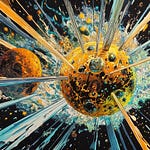In the early 20th century, scientists embarked on a journey that would revolutionize our understanding of the universe. This journey led to the development of quantum mechanics, a theory that describes the behavior of matter and energy at the smallest scales. At the heart of this revolution was a groundbreaking approach called matrix mechanics, pioneered by Werner Heisenberg and further developed by other brilliant minds of the time.
The Birth of Matrix Mechanics
Imagine you're trying to solve a complex puzzle, but instead of fitting pieces together, you're dealing with mathematical equations that describe the invisible world of atoms and subatomic particles. This was the challenge faced by physicists in the 1920s as they grappled with understanding the behavior of electrons in atoms.
In 1925, a young German physicist named Werner Heisenberg had a revolutionary idea. Instead of trying to visualize electrons as tiny particles orbiting the nucleus like planets around the sun (which was the prevailing model at the time), Heisenberg proposed a radically different approach.
He suggested that we should focus on what we can actually measure and observe about atoms, rather than trying to imagine their internal structure.
Heisenberg's insight led to the development of matrix mechanics, the first mathematically consistent formulation of quantum mechanics. But what exactly is matrix mechanics, and why was it so revolutionary?
Understanding Matrix Mechanics: The Orchestra Analogy
To grasp the essence of matrix mechanics, let's imagine an orchestra.
In a classical orchestra, each musician plays a specific instrument, producing distinct notes at precise moments. This is analogous to classical physics, where particles have definite positions and velocities at all times.
Now, imagine a quantum orchestra. In this strange ensemble, the musicians don't play individual notes. Instead, they produce a complex harmony that represents all possible notes simultaneously. The conductor (representing a scientist making a measurement) can only hear specific harmonies, never individual notes.
In this quantum orchestra:
1. The musicians represent quantum states.
2. The harmonies represent the probabilities of different measurement outcomes.
3. The conductor's act of listening represents the act of measurement, which collapses the quantum state into a specific outcome.
This analogy captures the essence of matrix mechanics. Instead of describing particles with definite properties, matrix mechanics uses matrices (mathematical arrays of numbers) to represent the probabilities of different measurement outcomes.
The Power of Matrices
Why use matrices? Matrices are powerful mathematical tools that can represent complex relationships between multiple variables. In quantum mechanics, these variables might include position, momentum, energy, and other properties of particles.
Think of a matrix as a grid of numbers, like a spreadsheet. Each cell in this grid represents a potential transition between quantum states. When physicists perform calculations using these matrices, they can predict the probabilities of different measurement outcomes without needing to visualize the particle's exact path or position.This approach was revolutionary because it allowed physicists to make accurate predictions about atomic behavior without relying on classical concepts that broke down at the quantum scale.
The Uncertainty Principle: A Consequence of Matrix Mechanics
One of the most profound implications of matrix mechanics is the Heisenberg Uncertainty Principle.
This principle states that there's a fundamental limit to how precisely we can measure certain pairs of physical properties, such as position and momentum, simultaneously.
To understand this, let's return to our quantum orchestra analogy. Imagine trying to determine both the exact pitch (analogous to position) and the exact rhythm (analogous to momentum) of a note in the quantum harmony. The more precisely you try to measure the pitch, the less certain you become about the rhythm, and vice versa.
This isn't due to a lack of measurement precision, but a fundamental property of the quantum world. In matrix mechanics, this uncertainty arises from the fact that certain pairs of matrices (representing different physical properties) don't commute – meaning the order in which you multiply them matters.
The uncertainty principle has far-reaching consequences, from limiting the precision of atomic clocks to enabling quantum tunneling, a phenomenon where particles can pass through barriers they classically shouldn't be able to penetrate.
Quantum Superposition and Measurement
Another key concept in matrix mechanics is quantum superposition.
In our quantum orchestra, remember that all possible notes are played simultaneously until a measurement is made. This is analogous to how quantum particles can exist in multiple states at once until they're observed.
When a measurement is made, the quantum state "collapses" into one specific outcome. In matrix mechanics, this is represented by the matrix for the measured property selecting one of its eigenvalues (special values associated with the matrix).
This process explains phenomena like the famous double-slit experiment, where particles seem to behave like waves until they're measured, at which point they behave like particles.
The Impact of Matrix Mechanics
Matrix mechanics, along with other formulations of quantum mechanics, has had a profound impact on our understanding of the universe and on technology:
1. Atomic Structure: It provided a framework for understanding the behavior of electrons in atoms, explaining the periodic table and chemical bonding.
2. Quantum Computing: The principles of superposition and measurement in matrix mechanics are fundamental to the development of quantum computers, which promise to revolutionize computing for certain types of problems.
3. Semiconductors: Our understanding of electron behavior in materials, derived from quantum mechanics, led to the development of semiconductors, which are the foundation of modern electronics.
4. Quantum Cryptography: The uncertainty principle and quantum measurement form the basis for ultra-secure communication systems.
5. Medical Imaging: Technologies like Magnetic Resonance Imaging (MRI) rely on principles of quantum mechanics to create detailed images of the human body.
Challenges and Interpretations
Despite its success, matrix mechanics and quantum mechanics in general pose philosophical challenges. The probabilistic nature of quantum predictions and the role of measurement in determining outcomes have led to various interpretations of what quantum mechanics means for the nature of reality.
Some interpretations, like the Copenhagen Interpretation (partly developed by Niels Bohr, who also contributed to early quantum theory), suggest that quantum systems don't have definite properties until they're measured.
Others, like the Many-Worlds Interpretation, propose that every possible outcome of a quantum measurement occurs in separate, branching universes.
These interpretations continue to be debated, highlighting the profound impact that matrix mechanics and quantum theory have had not just on physics, but on our understanding of the nature of reality itself.
Matrix Mechanics in Science Fiction
The mind-bending concepts of matrix mechanics and quantum physics have inspired numerous works of science fiction. These stories often explore themes of reality, perception, and the nature of existence, which resonate with the counterintuitive ideas presented by quantum mechanics.
Here are some notable examples:
The Matrix (1999)
The Wachowskis' influential film "The Matrix" draws heavily on philosophical concepts and quantum mechanics ideas. While not explicitly about matrix mechanics, the film's premise of a simulated reality controlled by machines echoes some of the strange implications of quantum theory.
Connection to Matrix Mechanics: The film's exploration of perception and reality mirrors how matrix mechanics describes the behavior of quantum particles. Just as the characters in the Matrix can bend the rules of their simulated environment, quantum particles behave in ways that defy classical intuition.
Quantum Superposition: The idea that the Matrix is a construct that can be manipulated reflects the concept of quantum superposition, where particles can exist in multiple states simultaneously until observed.
Dark City (1998)
This neo-noir science fiction film features a protagonist who discovers that his city is controlled by mysterious beings manipulating reality, including time and memory.
Connection to Matrix Mechanics: The manipulation of memories and perceptions in "Dark City" can be likened to the principles of matrix mechanics, where the underlying reality is subject to change based on observation and measurement.
Quantum Measurement: The way the city changes each night, with people's memories and identities shifting, mirrors how quantum states collapse upon measurement in matrix mechanics.
Directed by David Cronenberg, this film involves a virtual reality game that blurs the lines between reality and simulation.
Connection to Matrix Mechanics: The concept of layered realities in "eXistenZ" echoes the ideas in matrix mechanics about states and measurements. The characters navigate through different levels of existence, paralleling how quantum states can exist simultaneously until measured.
Reality as Information: The film's portrayal of reality as a construct of information aligns with the matrix mechanics view of quantum states as mathematical constructs rather than physical entities.
Permutation City by Greg Egan (1994)
This novel explores consciousness and identity within a simulated reality where characters can exist in multiple forms.
Connection to Matrix Mechanics: Egan's work often incorporates advanced concepts from quantum theory, including ideas related to matrix mechanics. The exploration of identity in a digital realm resonates with themes of superposition and measurement in quantum mechanics.
Multiple Realities: The novel's concept of multiple, co-existing versions of reality reflects the Many-Worlds interpretation of quantum mechanics, which arose from matrix mechanics and other quantum theories.
These science fiction works, while not always scientifically accurate, capture the essence of the strange and counterintuitive nature of quantum mechanics. They invite us to question our perceptions of reality and consider the implications of a world governed by quantum principles.
The Legacy of Matrix Mechanics
Matrix mechanics, developed by Heisenberg and refined by his contemporaries, marked a paradigm shift in physics. It moved us away from classical, deterministic models of the universe towards a probabilistic understanding based on what we can measure and observe.
While the mathematics of matrix mechanics may seem abstract, its implications are profound and far-reaching. From the devices we use every day to our deepest questions about the nature of reality, the legacy of matrix mechanics continues to shape our world.
As we continue to explore the quantum realm, from developing quantum computers to probing the mysteries of quantum gravity, the insights provided by matrix mechanics remain as relevant and revolutionary as ever. It reminds us that sometimes, to understand the deepest truths of our universe, we need to be willing to embrace new ways of thinking, even when they challenge our intuitions about how the world works.












Matrix Mechanics: Understanding the Quantum World